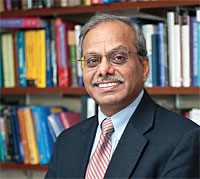New models point way toward better solar cells
According to the United States Department of Energy, the amount of solar energy that hits the surface of the earth every hour is greater than the total amount of energy that the entire human population requires in a year.
To put this in perspective, roughly 100 square miles of solar panels placed in the southwestern U.S. could power the country.
But placing those panels, which would advance energy independence, involves obstacles including cost. Purdue researchers are working to create a new generation of low-cost solar cells that could transform global energy production.

Doctoral student Biswajit Ray and Muhammad Ashraful Alam, professor of electrical and computer engineering. Purdue University photo/Andrew Hancock.
One project is led by Rakesh Agrawal, the Winthrop E. Stone Distinguished Professor of Chemical Engineering. Also working on the research are Mark Lundstrom, the Don and Carol Scifres Distinguished Professor of Electrical and Computer Engineering; Muhammad Ashraful Alam, professor of electrical and computer engineering; and Eric Stach, a researcher at Brookhaven National Laboratory.
Two major drawbacks exist for commercial silicon solar cells: They are expensive to manufacture and must operate for eight to 12 years just to recoup the amount of energy needed to manufacture them, Alam says.
Purdue research funded by the U.S. Department of Energy strives to achieve critical requirements not met by other solar technologies: It should be mass-producible at low cost and not limited by the availability of materials.
"To date, none of the photovoltaic technologies simultaneously meets all these constraints," says Agrawal, who received the National Medal of Technology and Innovation — the nation's highest honor for technological achievement — from President Barack Obama in September 2011.
He is working on new solar cells that hinge on developing an ink using tiny "nanocrystals" made of a material called copper zinc tin sulfide, or CZTS. Because the materials are abundantly available, the CZTS technology poses no resource hurdles, Agrawal says.
Agrawal's lab was the first to make CZTS nanocrystals, which enabled creation of a light-absorbing ink.
"The concept is that once you have an ink you can print photovoltaic cells very fast, so they become very inexpensive to manufacture," Agrawal says.
In other work led by Alam and doctoral student Biswajit Ray, researchers are developing plastic solar cells by mixing two liquid components and annealing, or heating the mixture, which solidifies into a thin polymer film. The cells are portable, lightweight and transparent. The flexible cells might be attached to windows to light buildings, or coated onto laptops and other portable electronics as a power source.
However, although the plastic solar cells are far less expensive to produce than silicon cells, they have a low efficiency and currently break down in the sunlight within a year of use.
"Once you have an ink you can print photovoltaic cells very fast, so they become very inexpensive to manufacture."
– Rakesh Agrawal
"It's an unknown, unproven technology, but if we could make it work it could transform everything," Alam says. "Roughly one-fourth to one-third of U.S. solar-energy research funding is going into these organic solar cells. They represent a potential game changer."
The polymer mixture must be annealed for just the proper time and precise temperature for the cells to be as efficient as possible.
"We mix two polymers and heat it, but we don't know how long we should heat it, or at what temperature to get the best efficiency," says Ray, who, working with Alam, has developed the first model that determines the proper annealing time and temperature depending on the polymers used.
Ray also has shown how the cells degrade when operated in sunlight. That model interprets experimental results, describing how the two polymer components "phase segregate," or come apart over time.
"If you understand how it phase segregates, then you should also be able to understand how to design these polymers differently so that they remain functional over many years," Ray says.

Rakesh Agrawal, the Wintrop E. Stone Distinguished Professor of Chemical Engineering. Purdue University photo/Andrew Hancock.
Findings were detailed in research papers appearing earlier this year in the journal Applied Physics Letters and Solar Energy Materials and Solar Cells.
"This kind of modeling allows you to think creatively and systematically," Alam says. "Otherwise, you cannot perfect this technology just by trial-and-error experimentation because solar cells are very complex."
Models may enable engineers to perfect solar cells, just as they did for the computer chips.
"Modeling and simulation transformed the silicon semiconductor industry during the 1980s," Alam says. "That's when the industry was really able to design integrated circuits and microprocessors and test them ahead of time using models to predict their performance."
For the plastic solar cells to effectively compete with other energy technologies, new materials that don't degrade quickly will be needed, Alam says.
"You need 15 percent efficiency and 15-year lifetime for polymer solar cells to be economically competitive with oil and natural gas. We have framed the problem very cleanly, but the solutions are still not there."
The work is associated with the Energy Frontier Research Center at Columbia University. The Columbia EFRC is a collaboration between the University of Texas, Purdue and the Brookhaven National Laboratory.
